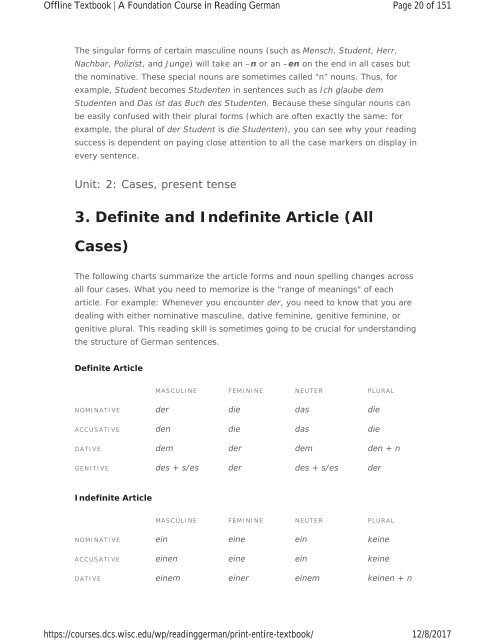A Foundation Course in Reading German, 2017a
A Foundation Course in Reading German, 2017a
A Foundation Course in Reading German, 2017a
You also want an ePaper? Increase the reach of your titles
YUMPU automatically turns print PDFs into web optimized ePapers that Google loves.
Offl<strong>in</strong>e Textbook | A <strong>Foundation</strong> <strong>Course</strong> <strong>in</strong> Read<strong>in</strong>g <strong>German</strong><br />
https://courses.dcs.wisc.edu/wp/read<strong>in</strong>ggerman/pr<strong>in</strong>t-entire-textbook/<br />
Page 20 of 151<br />
12/8/2017<br />
The s<strong>in</strong>gular forms of certa<strong>in</strong> mascul<strong>in</strong>e nouns (such as Mensch, Student, Herr,<br />
Nachbar, Polizist, and Junge) will take an –n or an –en on the end <strong>in</strong> all cases but<br />
the nom<strong>in</strong>ative. These special nouns are sometimes called “n” nouns. Thus, for<br />
example, Student becomes Studenten <strong>in</strong> sentences such as Ich glaube dem<br />
Studenten and Das ist das Buch des Studenten. Because these s<strong>in</strong>gular nouns can<br />
be easily confused with their plural forms (which are often exactly the same: for<br />
example, the plural of der Student is die Studenten), you can see why your read<strong>in</strong>g<br />
success is dependent on pay<strong>in</strong>g close attention to all the case markers on display <strong>in</strong><br />
every sentence.<br />
Unit: 2: Cases, present tense<br />
3. Def<strong>in</strong>ite and Indef<strong>in</strong>ite Article (All<br />
Cases)<br />
The follow<strong>in</strong>g charts summarize the article forms and noun spell<strong>in</strong>g changes across<br />
all four cases. What you need to memorize is the "range of mean<strong>in</strong>gs" of each<br />
article. For example: Whenever you encounter der, you need to know that you are<br />
deal<strong>in</strong>g with either nom<strong>in</strong>ative mascul<strong>in</strong>e, dative fem<strong>in</strong><strong>in</strong>e, genitive fem<strong>in</strong><strong>in</strong>e, or<br />
genitive plural. This read<strong>in</strong>g skill is sometimes go<strong>in</strong>g to be crucial for understand<strong>in</strong>g<br />
the structure of <strong>German</strong> sentences.<br />
Def<strong>in</strong>ite Article<br />
MASCULINE FEMININE NEUTER PLURAL<br />
NOMINATIVE der die das die<br />
ACCUSATIVE den die das die<br />
DATIVE dem der dem den + n<br />
GENITIVE des + s/es der des + s/es der<br />
Indef<strong>in</strong>ite Article<br />
MASCULINE FEMININE NEUTER PLURAL<br />
NOMINATIVE e<strong>in</strong> e<strong>in</strong>e e<strong>in</strong> ke<strong>in</strong>e<br />
ACCUSATIVE e<strong>in</strong>en e<strong>in</strong>e e<strong>in</strong> ke<strong>in</strong>e<br />
DATIVE e<strong>in</strong>em e<strong>in</strong>er e<strong>in</strong>em ke<strong>in</strong>en + n


















